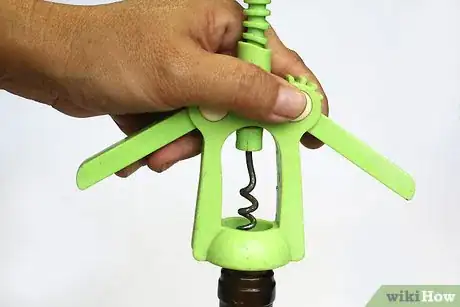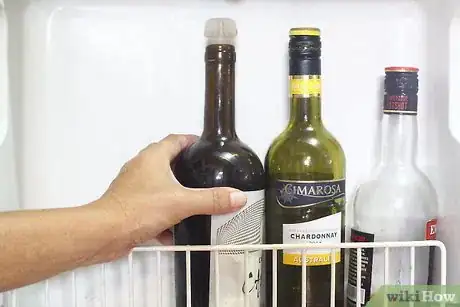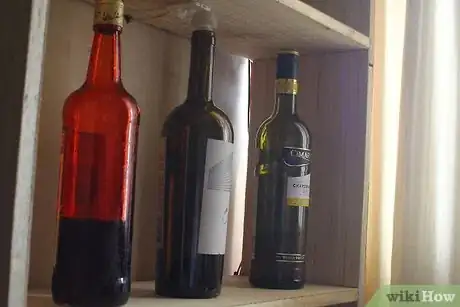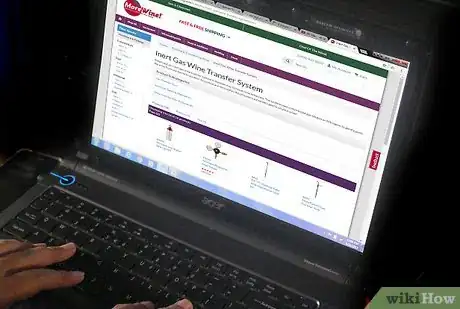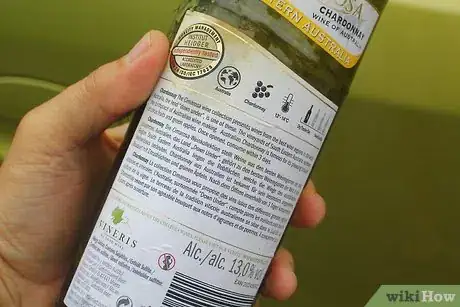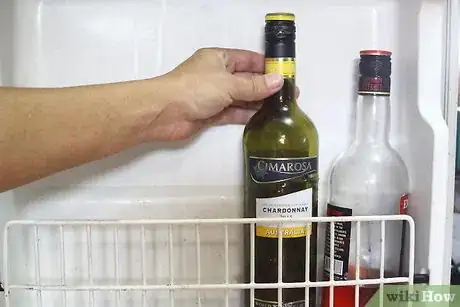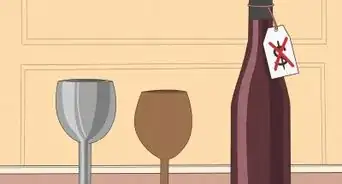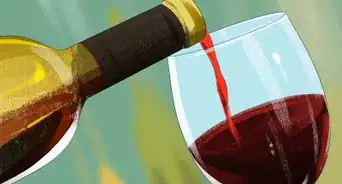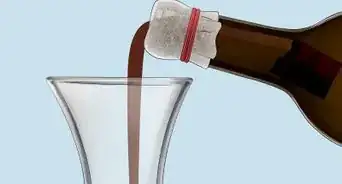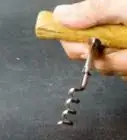This article was co-authored by Murphy Perng. Murphy Perng is a Wine Consultant and the Founder and Host of Matter of Wine, a business that produces educational wine events, including team-building experiences, networking events, and private parties. Based in Los Angeles, California, Murphy has served as a Wine Educator for clients such as Google, Buzzfeed, Tiktok, Snapchat, and Equinox and been featured on National Geographic and The Somm Journal. Murphy possesses her WSET (Wine & Spirit Education Trust) Level 3 Advanced Certification.
There are 8 references cited in this article, which can be found at the bottom of the page.
This article has been viewed 210,392 times.
Once you open a bottle of wine, it can actually improve in flavor over the next few hours as it mixes with the oxygen in the air. However, after a longer period of time, oxygenation will turn the flavor dull. Learn how to keep the remaining wine you don’t drink from an open bottle as fresh as possible.
Steps
Sealing and Storing Wine
-
1Cork the bottle. Close a bottle of wine after pouring individual glasses from it. Use the cork that the bottle came with, or a reusable wine stopper.
- Re-cork properly by inserting the cork into the bottle in the same direction as when you pulled it out. Avoid putting the “clean” side of the cork into the bottle facing the wine, even if it seems easier to do so, as it may not be clean and could in fact contaminate the wine.[1]
- If you don’t have a cork or stopper available to seal your wine bottle, use a small piece of plastic wrap to cover the mouth of the bottle, then secure with a rubber band.[2]
- If the bottle has a screw cap, you should screw it back on.[3]
-
2Stick the bottle in a chiller or fridge. Once the bottle is re-corked, put it into a wine chiller or the refrigerator. Keep in mind, though, that once the wine touches the air, it will begin to lose its fruit and freshness quickly. It's best to finish an opened bottle within 2-3 days.[4]
- Don’t store the wine bottle horizontally on its side once opened, whether on a rack or in the refrigerator. This will expose a greater surface area of the wine to oxygen.[5]
- Note that keeping wine in the refrigerator will not keep it from going bad, but it can slow down the chemical process responsible for making the wine lose its flavor.
Advertisement -
3Avoid heat and light. Keep an opened wine bottle away from direct sunlight and high heat. Favor cool, dark areas or a fridge.
- Avoid storage in temperatures above 70° F. Also keep the wine away from a window to prevent heating and discoloration from the sun.[6]
- When taking leftover red wine out of storage in the fridge or other cool place, let it warm up gradually. Place the bottle in lukewarm water, or simply bring it out of the fridge about an hour before serving.[7]
- If you're passionate about your wines, investing in a wine cooler that will keep your wine at a consistent temperature might be a good idea.[8]
Removing or Replacing Oxygen from Wine
-
1Transfer to a half bottle. Pour your leftover wine into a half-size wine bottle and seal. This will reduce the surface area of the wine that’s exposed to oxygen, slowing the aging process.
- Make sure your half bottle of leftover wine is sealed tightly with an appropriate cork, stopper, or screw-top.
- Save empty half bottles, which you can often find when buying dessert wines, and reuse over and over again for this purpose.[9]
- If you don’t have any half bottles on hand, you can use another small glass container that seals tightly.
-
2Purchase a vacuum pump. Buy a vacuum cap system for wine, which removes the oxygen from inside the bottle. Potentially lengthen the freshness of leftover wine in this way.
- You may want to invest in this device if you frequently have opened bottles of wine to keep, or drink varieties particularly prone to oxygenating, like full-bodied white wines such as oaked Chardonnay or Viognier.[10]
- Note that there is some disagreement about the effectiveness of wine vacuums. Some say that the oxygen removal is only partial, or it can actually damage the flavor of the wine due to extracting its aromas as well as the oxygen.[11]
-
3Invest in an inert gas system. Replace the oxygen in an opened bottle of wine with an inert gas, most commonly Argon. You can buy a device for this purpose from wine retailers.
- Try an aerosol spray for an inexpensive option, or a more sophisticated system like the Coravin.[12]
- Invest in this system if you’re a wine connoisseur who frequently needs to keep open bottles, as in a restaurant or other serving setting.
Accounting for Different Types of Wine
-
1Take extra care with sparkling wine. Avoid attempting to keep sparkling wine for more than one to three days. Put it in the refrigerator and seal it to avoid losing its carbonation.
- Get a stopper specifically made for storing sparkling wine, which will more securely seal the bottle. A regular cork will pop out due to carbonation.[13]
- Don’t use a vacuum pump on sparkling wine bottles, as it will suck out the carbonation of the wine.
- Some people enjoy day-old sparkling wine like champagne more than when it’s freshly opened, due to the slight decrease in carbonation and rounding out of flavors. However, don’t depend on the flavor remaining after more than 24 hours.
-
2Put reds in the fridge, too. Keep opened bottles of red wine, not just white wine, in a wine chiller or the fridge. Just allow leftover red wine to warm back to room temperature before serving.
- Note that dark, rich reds like Cabernet Sauvignon and Petite Sirah will generally keep for longer than lighter red varieties like Pinot Noir.
- Aged wine older than eight to ten years, and organic or sulfite-free wines, are also more susceptible to going bad more quickly.[14]
-
3Keep long-lasting fortified and box wine. Try keeping fortified wine, such as Marsala, Port, or Sherry, for much longer than any other type of wine. You can also buy bag-in-a-box style wine for longer storage.
- Fortified wines can keep for longer due to the addition of brandy, or sugars in the case of dessert wines. Keep them for up to 28 days with a cork in the fridge.
- Keep boxed wine in the fridge and continue drinking from it for two to three weeks. Pay attention to and don’t drink beyond the given expiration date, as it is provided based on regulations for food stored in plastic.[15]
- Another method of keeping any wine for a very long time is to freeze it for use in cooking. Freeze wine into cubes or a block and keep it in the freezer in an airtight container for up to four to six months.[16]
-
4Finished.
Community Q&A
-
QuestionWhat if I've opened wine that has a screw top?
 Community AnswerClose the bottle tightly with the screw top that it came with and place it in a chiller or fridge for storage. Screw tops should have about the same effectiveness as a cork in terms of preserving flavor.
Community AnswerClose the bottle tightly with the screw top that it came with and place it in a chiller or fridge for storage. Screw tops should have about the same effectiveness as a cork in terms of preserving flavor. -
QuestionI no longer have the lid for a bottle of red wine. How can I store it without the lid?
 Community AnswerWrap the top in cling film making a tight seal. Wrap sellotape around that to make a harder seal. Drink the wine within 2 days or use it in a recipe.
Community AnswerWrap the top in cling film making a tight seal. Wrap sellotape around that to make a harder seal. Drink the wine within 2 days or use it in a recipe. -
QuestionCan we put ice in a glass of red wine?
 Alex LongmanCommunity AnswerYou could do so to chill it down. However, you could end up dulling down the flavour notes of the wine.
Alex LongmanCommunity AnswerYou could do so to chill it down. However, you could end up dulling down the flavour notes of the wine.
Warnings
- Always consume wine responsibly, as an adult 21 or over in the U.S.⧼thumbs_response⧽
References
- ↑ http://www.winemag.com/2015/05/15/5-tips-for-storing-opened-wine/
- ↑ http://www.stilltasty.com/fooditems/index/18697
- ↑ Murphy Perng. Certified Wine Consultant. Expert Interview. 19 February 2020.
- ↑ Murphy Perng. Certified Wine Consultant. Expert Interview. 15 March 2019.
- ↑ https://winefolly.com/tips/storing-open-red-wine/
- ↑ https://winefolly.com/tips/storing-open-red-wine/
- ↑ http://www.stilltasty.com/fooditems/index/18697
- ↑ Murphy Perng. Certified Wine Consultant. Expert Interview. 19 February 2020.
- ↑ http://vinepair.com/wine-101/guide-storing-open-wine/
- ↑ https://winefolly.com/tips/how-long-does-an-open-bottle-of-wine-last/
- ↑ https://winefolly.com/tips/storing-open-red-wine/
- ↑ https://www.thekitchn.com/the-best-way-to-preserve-an-open-bottle-of-wine-wine-for-all-213667
- ↑ https://winefolly.com/tips/storing-open-red-wine/
- ↑ https://winefolly.com/tips/storing-open-red-wine/
- ↑ https://winefolly.com/tips/how-long-does-an-open-bottle-of-wine-last/
- ↑ http://www.stilltasty.com/fooditems/index/18697
About This Article
Wine can lose its flavor if a bottle is left open overnight or longer, but luckily you’ve got several options to easily store it for drinking later. You could cover the bottle with plastic wrap and seal it with an elastic band. If you still have the cork, reinsert it into the bottle once you’ve finished drinking. Once you’ve sealed the bottle, put it in the fridge for storage, since this slows down the chemical process that makes it go bad. You should do this with red wine too, but remember to warm it back up to room temperature before drinking it, since red wine isn't usually drunk cold. Another option is to transfer your leftover wine to a half bottle, which will reduce the area of wine that’s exposed to oxygen. Remember that drinking old wine won't do you any harm, it just won't taste very good. For tips on how to remove oxygen from wine with a vacuum pump, read on!
